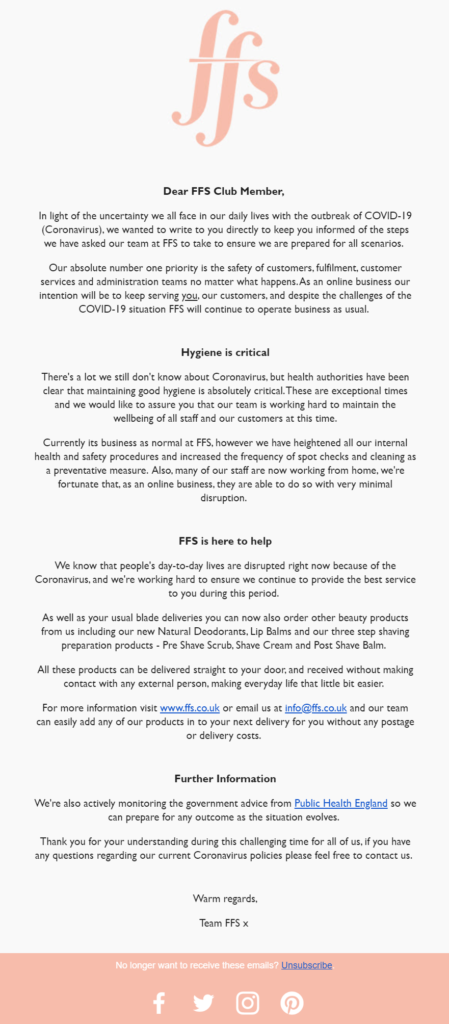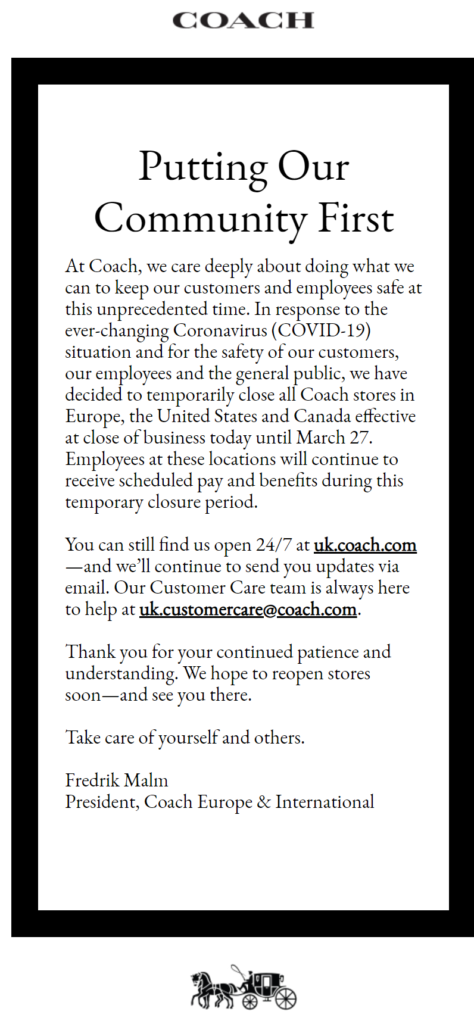

Marketing challenges
Effectively communicating your business continuity

What is business continuity?
Business continuity is about building a resilient framework that enables businesses to respond effectively at times of crisis or uncertainty. Rather than ‘firefighting’ in emergency situations, brands can return to business as usual (BAU) quickly and helps build confidence. By safeguarding the interests of key business stakeholders, brand reputation, and value-generating activities, staff, customers, and suppliers will be reassured that you can manage the unexpected.
How to communicate your plan?
Key to keeping confidence in your brand is how you communicate during uncertain times. When done right this can actually help grow awareness and boost your brand reputation.
As part of your continuity planning, you need to identify your key audiences. Most brands will be talking to employees, customers, suppliers, stakeholders, and more. Knowing how, when, and why you’re talking to each group will significantly help the effectiveness of your plan.
Choosing the right channel
Modern communication has developed far beyond the solitary email. Cross-channel automation platforms such as Dotdigital offer brands an extensive range of communication channels. But they’re still being under-utilized. During periods of uncertainty when your business continuity plan comes into action, these additional channels will be vital to reach and maintain contact with your key stakeholders.

Email is one of the furthest reaching channels accessible to brands. With nearly 4 billion email users around the world, email is an integral part of daily online life.
SMS
There are over 4.5 billion mobile phones in the world and that number just keeps growing. SMS as a communication channel for brands has a 98% read rate, so it must be seriously considered during a crisis.
Chat
Internet access is a luxury many of us take for granted nowadays. But it has also helped us get unprecedented access to brands and people around the world. Living in the globalized and interconnected world we’re in today, live chat is an increasingly in-demand channel.
Mobile apps
Of the 4.5 billion phones in the world today, over 3 billion of them are smartphones capable of hosting mobile apps. With the always-on mentality growing around the globe push notifications are a channel just waiting to be tapped into.
Social media
With 3.5 billion social media users worldwide, brands using social media properly and efficiently in times of uncertainty are guaranteed to make an impact. Reaching customers on their favorite social media platform is also going to have a positive effect on their opinion of a brand.
Talking to employees
When the decision is made to enact your business continuity plan, the first group you need to communicate to are your employees.
Whether you’re a small office or spread across the state, country, or even the world, staff need to be fully informed about what’s happening. This is made even more important when remote working is required of your staff.
Alerts and situation updates
For times when you need information shared immediately, you’ll find no better channel than SMS. Broadcast SMS allows you to deliver messages to all staff in over 150 countries.
Safety and wellbeing check-ups
Keep an eye on the safety and wellbeing of your employees with surveys. You can do this throughout your whole business continuity plan by automating these check-ins at regular intervals.
Communicating with key stakeholders
No matter the size of your business, there will be key stakeholders who need to be informed about potential changes to your daily work as you maintain BAU. These could be investors, suppliers, or distributors. Whoever they are, you need to carefully plan your communications.
Consider what they need to know, when they need to know it by, and how best to get these messages to them.
Continuity updates
Planning regular news updates for your stakeholders is a great way to keep them engaged. The success of this lies in your email marketing tactics.
Segmentation is going to be key. After all, your suppliers aren’t going to need to know all the information you need to share with investors. Dynamic content will help you ensure the only the relevant information is being sent to the right target audience.
Keeping customers updated
During times of business continuity, keeping customer confidence in your brand is going to make a huge difference to the success of your plan.
Broadcast comms
Putting a continuity plan into action will be an unprecedented situation for most brands. It’ll also be a highly unusual position for most of your customers. Keeping them informed about any changes to your business demonstrates your brand integrity in their eyes. Sending a broadcast from your CEO is a great way to improve trust and confidence and can be personalized for more impact.
Two-way conversations
Put customers’ minds at ease quickly and efficiently by introducing live chat to your website. This is going to be particularly effective if you’re an ecommerce brand and have had to close the doors of your brick-and-mortar stores.
Changes to events and activities
As you try to maintain BAU during troubling times, you may be required to change or cancel events or activities you’d organized for your customers. Make sure they’re well informed with plenty of notice with an impactful SMS.
Reassurances
Sending comforting reassurances directly into the palm of the customer’s hand can be achieved with a personalized push notification. With mobile devices never far from reach, remind customers that you’re still around and working hard to meet their needs.
What to say and when
These are just a few use-case examples. No one knows your customers, employees, or stakeholders as well as you do. You need to carefully consider which channel will have the greatest success with your audience.
What you say and when you say it will be an ongoing challenge during unpredictable times. Only you can make these decisions. But how you say it will make all the difference to your customers.
- Be open
- Be honest
- Be empathetic
Remember that your readers may be as scared, worried, or confused about the situation as you are.
Recent events have provided some amazing examples of brands focusing on their communities. They’ve been speaking to customers honestly as situations change. Focusing on the humans involved rather than the products or services they provide.



Before you reach out, run through these questions to determine whether it is a message that needs to be sent:
- Can I segment my audience? Whether you’re a big or a small organization, your database will interact with you differently. You will have more impact if you take this into consideration.
- Do I need to say this now? How time-sensitive is the message I want to send? Can I send it later?
- Does this information impact the reader? Will it affect the way they use our services or products? If they haven’t interacted with us for a while, do they need to know?
- Are people relying on me for answers? Considering our industry and the concerns affecting the public, are we providing them with the information they need now?
- Is there a risk in sending this? If it doesn’t have the impact I want, could it lead to unsubscribes, complaints or being marked as spam?
Stay on top
Get the latest and greatest marketing insight delivered to you weekly
Your email address will be handled in accordance with our Privacy Policy. We gather data around email opens & clicks using standard technologies including clear gifs to help us monitor and improve our newsletter.

